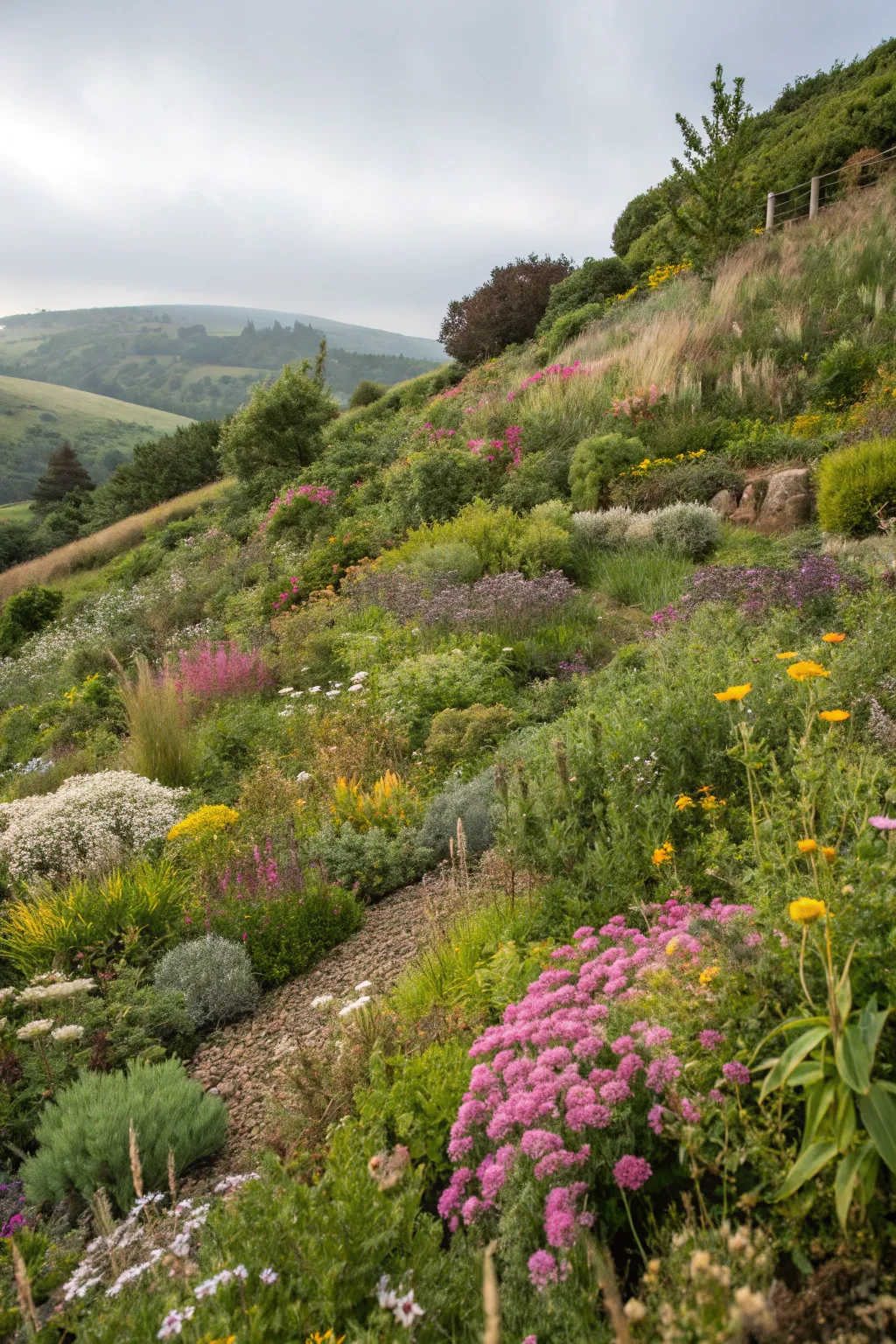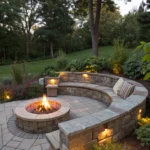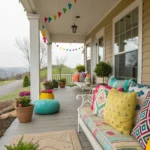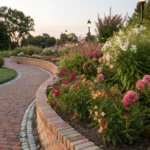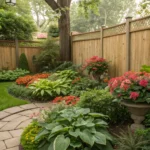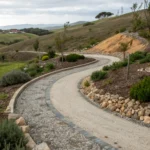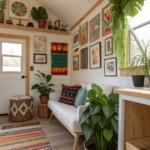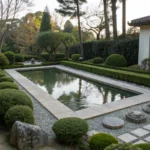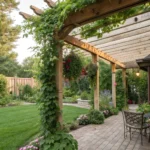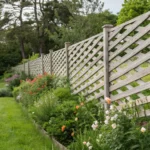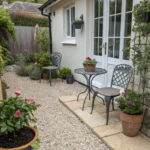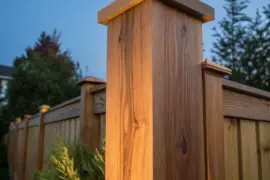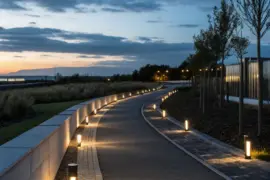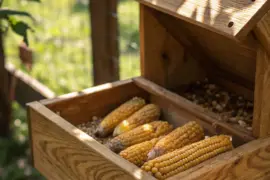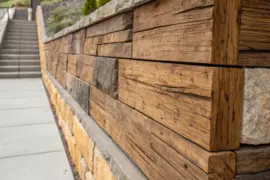Can a Hillside Really Become Your Favorite Outdoor Escape?
Transforming a sloped space might seem intimidating, but it’s amazing what a little creativity and some budget-savvy strategy can do. Picture a hillside garden that not only draws admiring glances, but also feels welcoming every time you step outside.
Ready to get inspired?
1. Layered Planting: Give Your Hillside Garden That Visual Punch
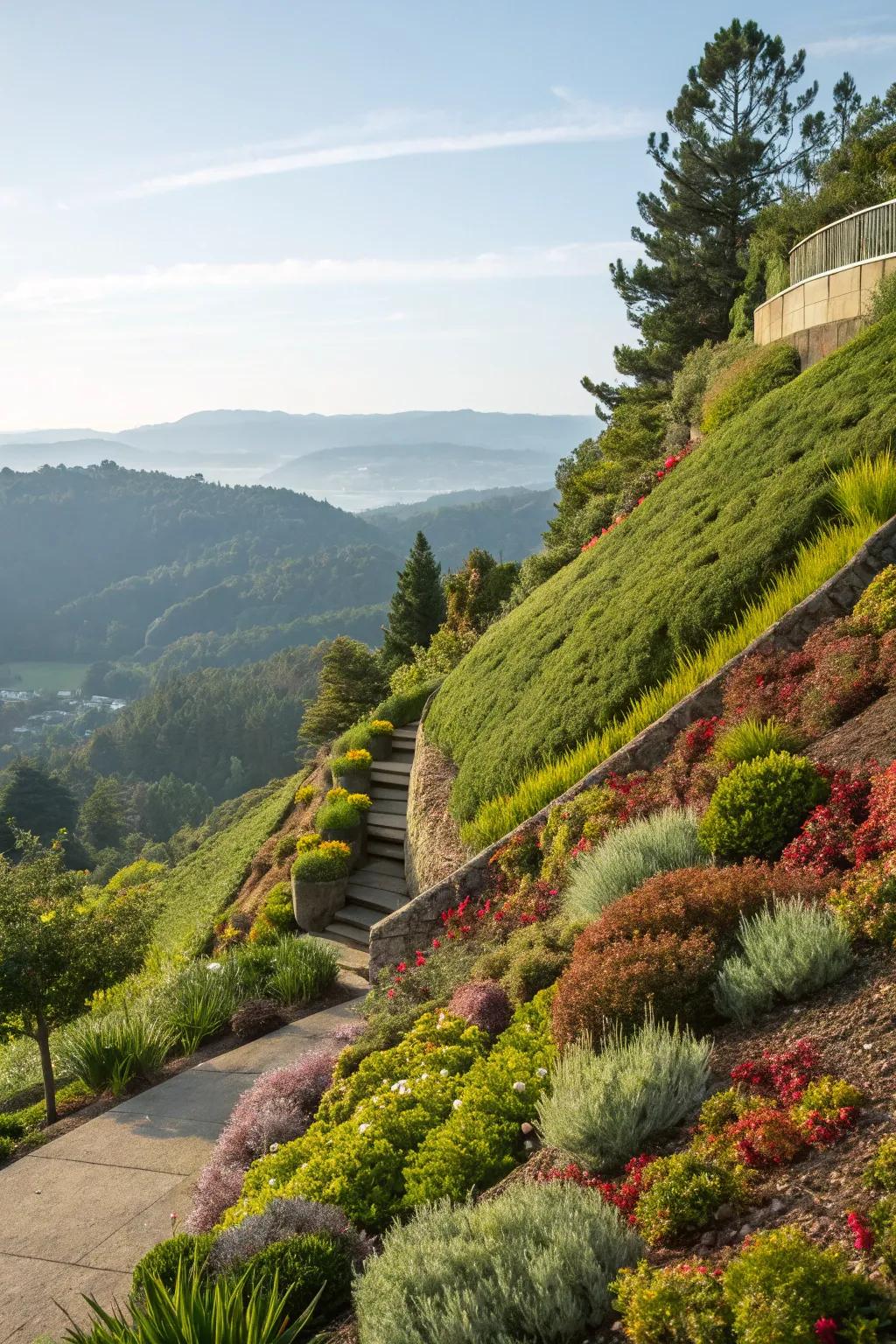
A well-designed hillside always starts with the illusion of fullness, and that’s where layered planting shines. It’s about playing with heights, textures, and colors so your garden feels both intentional and wildly lush—never chaotic.
I’ve seen the magic happen time and again when I’ve guided clients through this journey. When you arrange taller plants as a graceful backdrop and step down to mid-sized and finally low-growing plants in the front, your hillside transforms from a bland slope into a dynamic tapestry. It draws your eye upward and outward, making even modest spaces feel roomy and alive with possibility.
- Start with trees or shrubs for your tallest layer—they create structure all year round.
- Add a middle tier of flowering perennials or grasses for a burst of seasonal color.
- Use groundcovers or low annuals to soften edges and fill gaps at the front.
- Experiment with foliage shapes—mix broad leaves with wispy grasses for extra texture.
One of my favorite projects was working with the Taylors, who struggled to make their steep backyard more inviting. By layering silver-leafed artemisia at the highest tier, bold coneflowers in the middle, and a carpet of trailing thyme at their feet, we turned a sterile bank into their pride and joy. Now, every season brings a new layer of interest—and guests can’t believe it’s the same slope they started with.
You might give these a try:
2. Incorporate Edible Plants
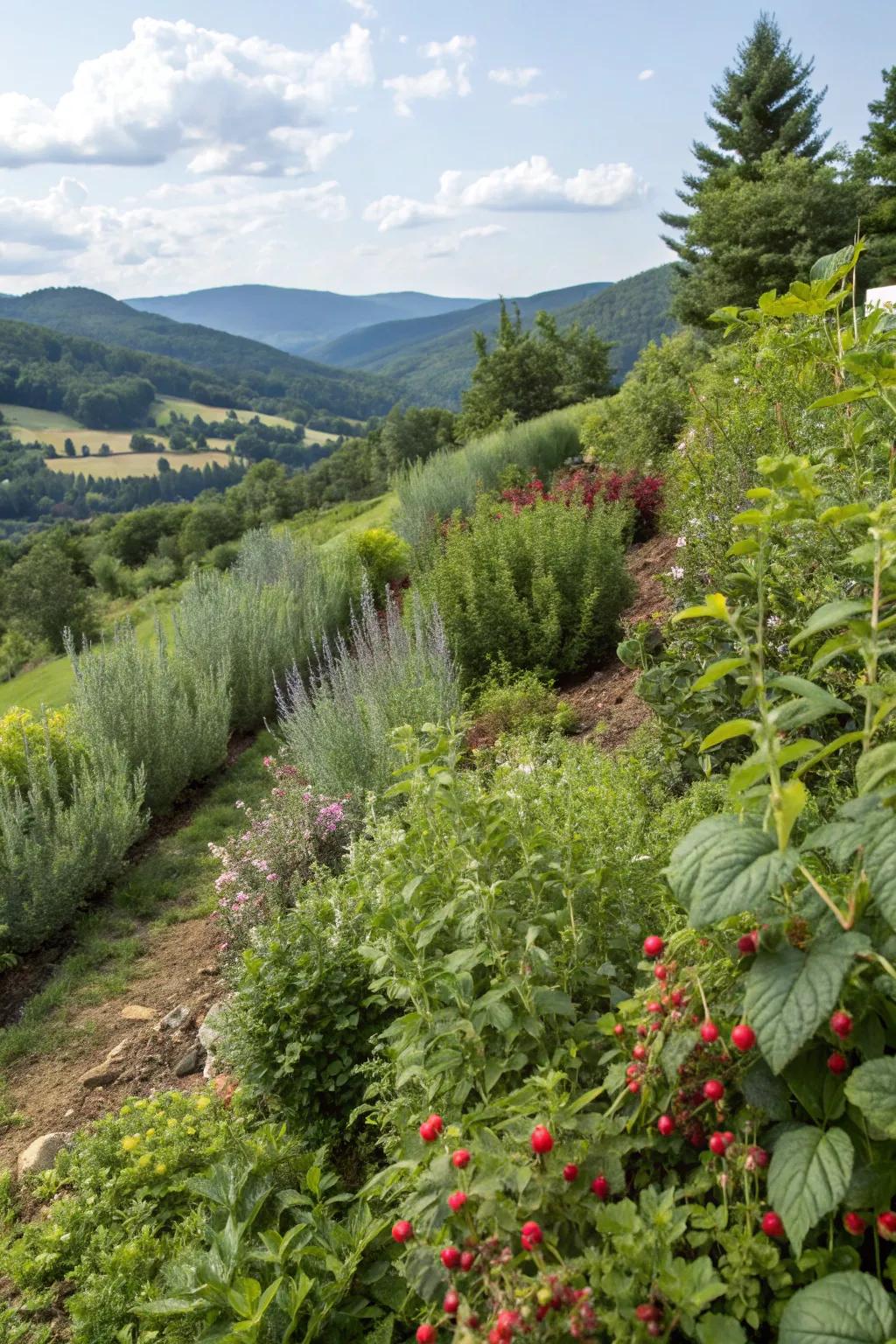
Adding edible plants like herbs or berry bushes is a practical and rewarding choice. My hillside garden has become a source of fresh flavors right outside my door.
Items that may come in handy:
3. Let’s Paint Your Hillside With Living Color!
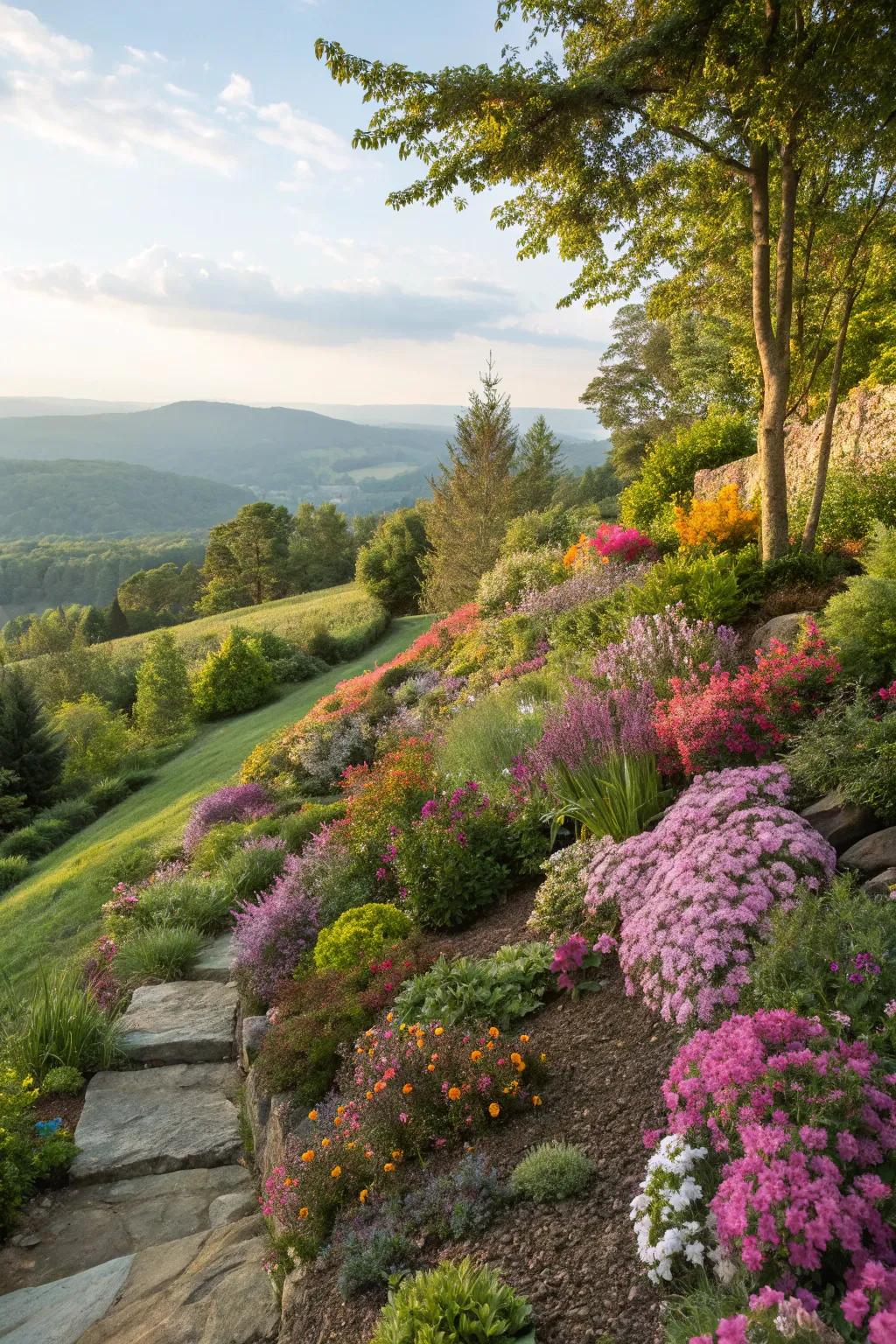
Adding a tapestry of perennials and ground covers isn’t just smart—it’s a true delight for the senses.
You cut down on watering, keep weeds at bay, and give your hillside a dynamic, ever-changing look. Those pops of color and texture? They work wonders for curb appeal, but the best part is how easy they are to care for once established.
I worked with the Thompsons on their first home, and their hillside was their biggest challenge. Instead of one big lawn, we planted swathes of drought-tolerant blooms and lush ground covers that tumbled down the slope. Each season brought something new—purple salvias in spring, golden coreopsis in summer, and silvery artemisia for year-round interest. The Thompsons still tell me their garden looks different every month, and watering takes just a fraction of their time.
Want to get the same lush, layered look on a budget? Consider these practical ideas:
Don’t forget soil preparation and grouping by water needs!
- Start with a base of tough groundcovers like creeping thyme or sedum.
- Plant drought-resistant perennials in drifts for long-lasting color.
- Use mulch between plantings to suppress weeds and retain moisture.
- Mix in bulbs and grasses for height and seasonal variety.
Why settle for a plain hillside when you can have a living masterpiece?
May just do the trick:
4. Pure Tranquility!
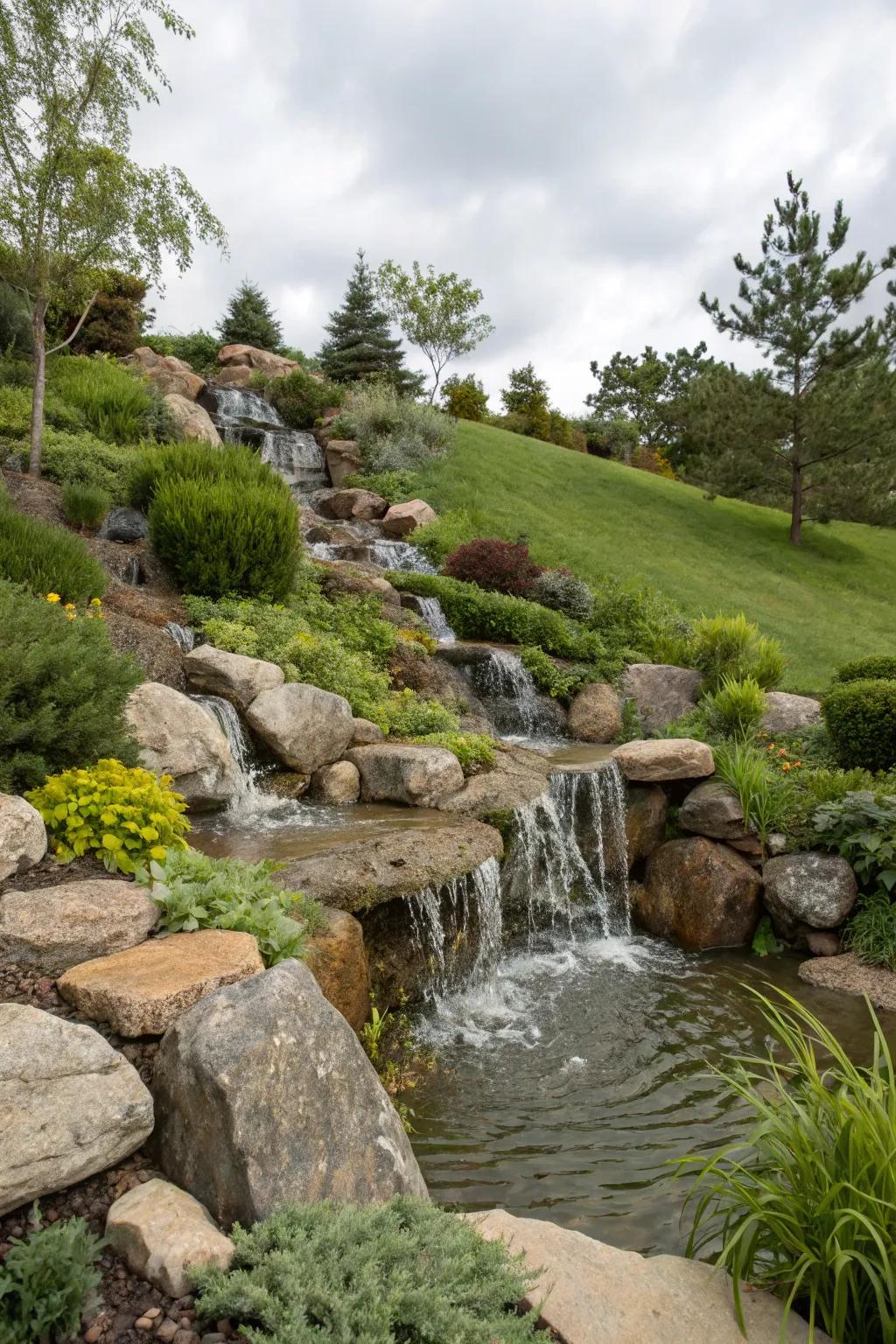
There’s something almost magical about the sound of water trickling down a hillside. Even the smallest water feature can turn a garden into a peaceful sanctuary.
Let’s be honest—on a hot day, isn’t the whisper of moving water exactly what you crave?
Whether you’re working with a grand slope or a gentle incline, adding a water feature is easier than you think. Choose the right spot by looking for areas where water naturally wants to flow—gravity is your ally on a hillside!
- Bamboo water fountain: Perfect for small spaces.
- Ceramic tiered fountain: Adds an elegant touch.
- Solar-powered water feature: Eco-friendly option.
A simple fountain or pond can attract birds, soothe your mind, and even mask unwanted noise. With a thoughtful design, you don’t need a big budget for a big impact—just a little inspiration and a willingness to get your hands (slightly) wet.
Give these a look:
5. Why Not Zen?
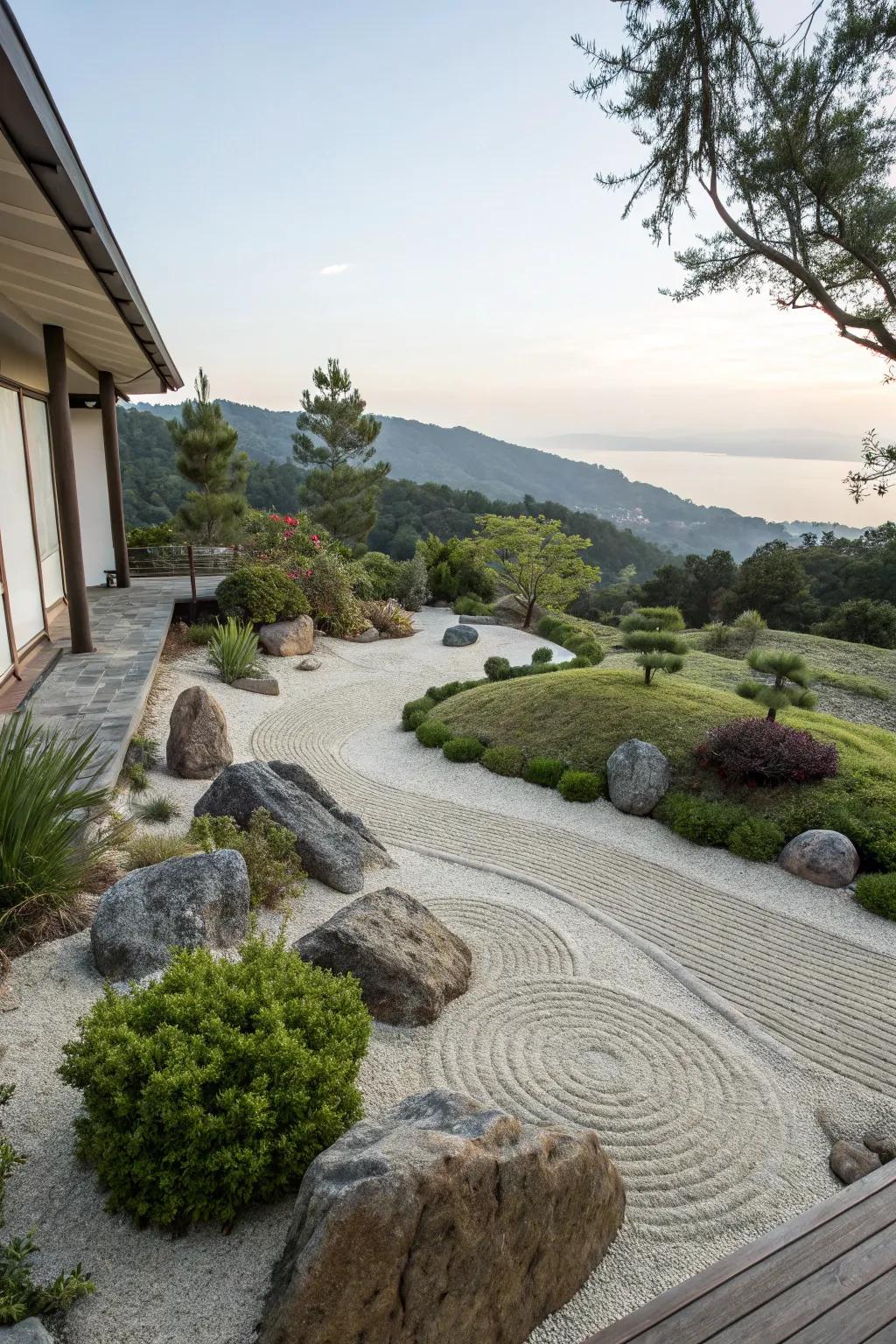
A hillside corner can become a zen sanctuary with just a few thoughtful touches—raked sand, smooth stones, and maybe a single elegant maple or ornamental grass.
Sometimes, the simplest spaces inspire the deepest calm.
If you crave a peaceful retreat, try carving out a little spot for reflection and gentle beauty. Just imagine tracing soft patterns in the sand as evening settles, letting the world fall away for a while.
A few relevant products:
6. Rustic Wood, Lasting Charm
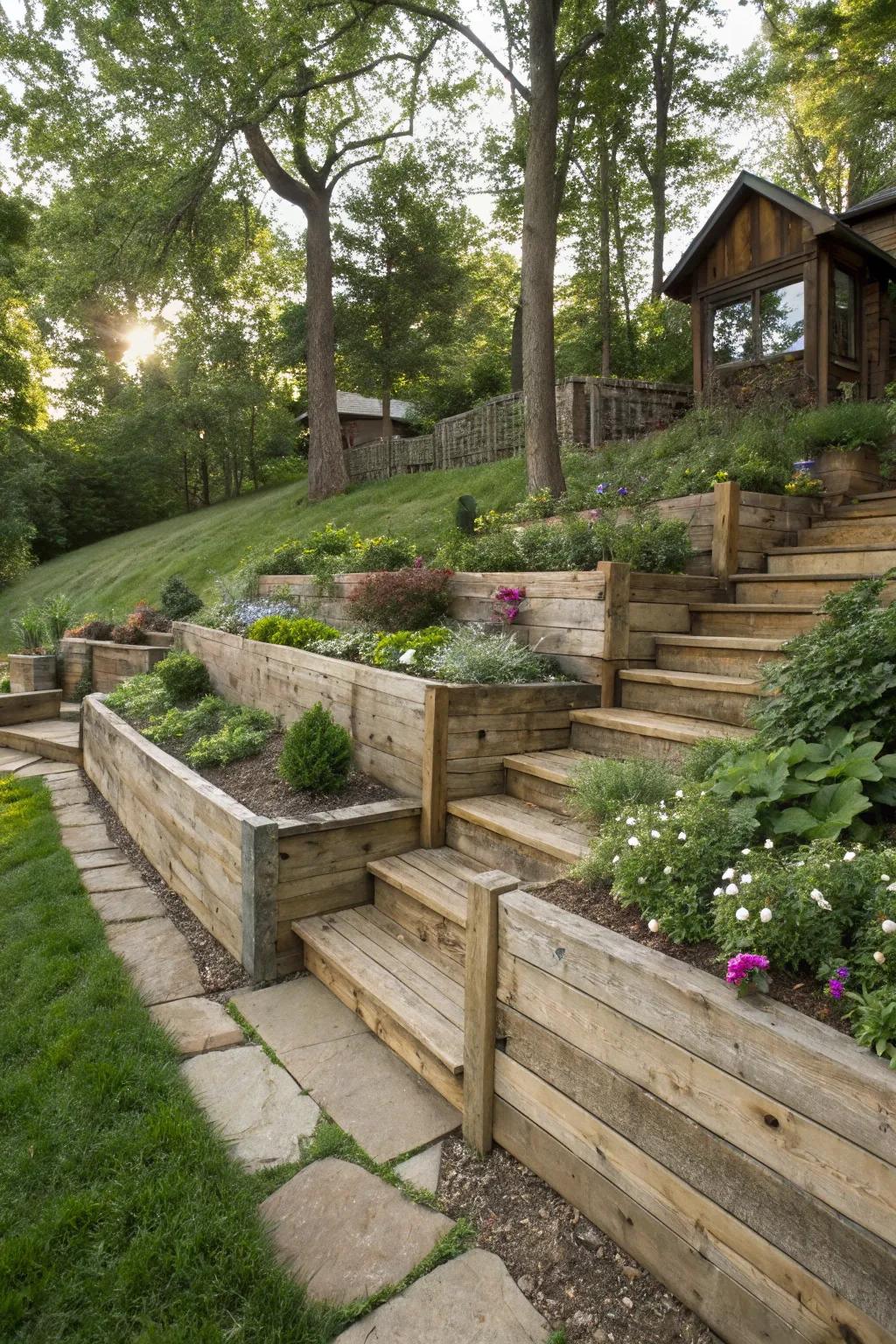
Reclaimed wood brings history, warmth, and character to any hillside project. If you love the look of materials with a story, this one’s for you! Get creative with your design:
- Build terraced steps that wind gracefully up your slope.
- Install rustic retaining walls that double as casual seating for an afternoon break.
Old boards often weather storms better than new ones—sometimes, in gardening as in life, age is an advantage.
A little imagination (and a sturdy pair of gloves) can turn cast-off planks into showstopping features on a dime.
Products that could assist:
7. Mulch—What’s the Secret?
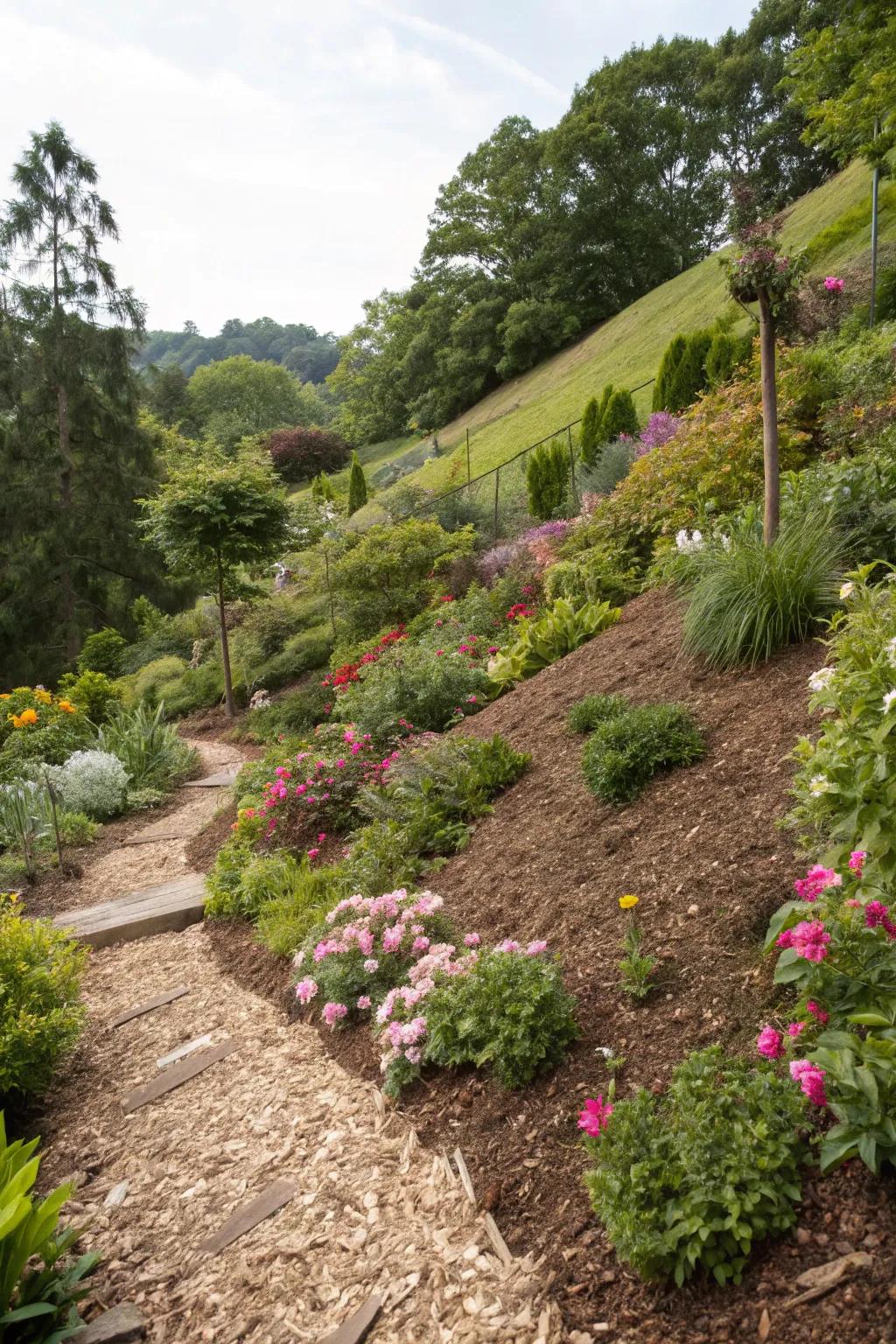
If you want to keep your hillside thriving without constant fuss, mulch is your best friend. It’s amazing how a simple layer of bark or gravel mulch can lock in moisture and keep those pesky weeds from taking over.
A tiny change, yet what a difference. Isn’t it funny how sometimes the simplest solutions are the most powerful?
Check these products out:
8. How Can Drip Irrigation Transform Your Slope?
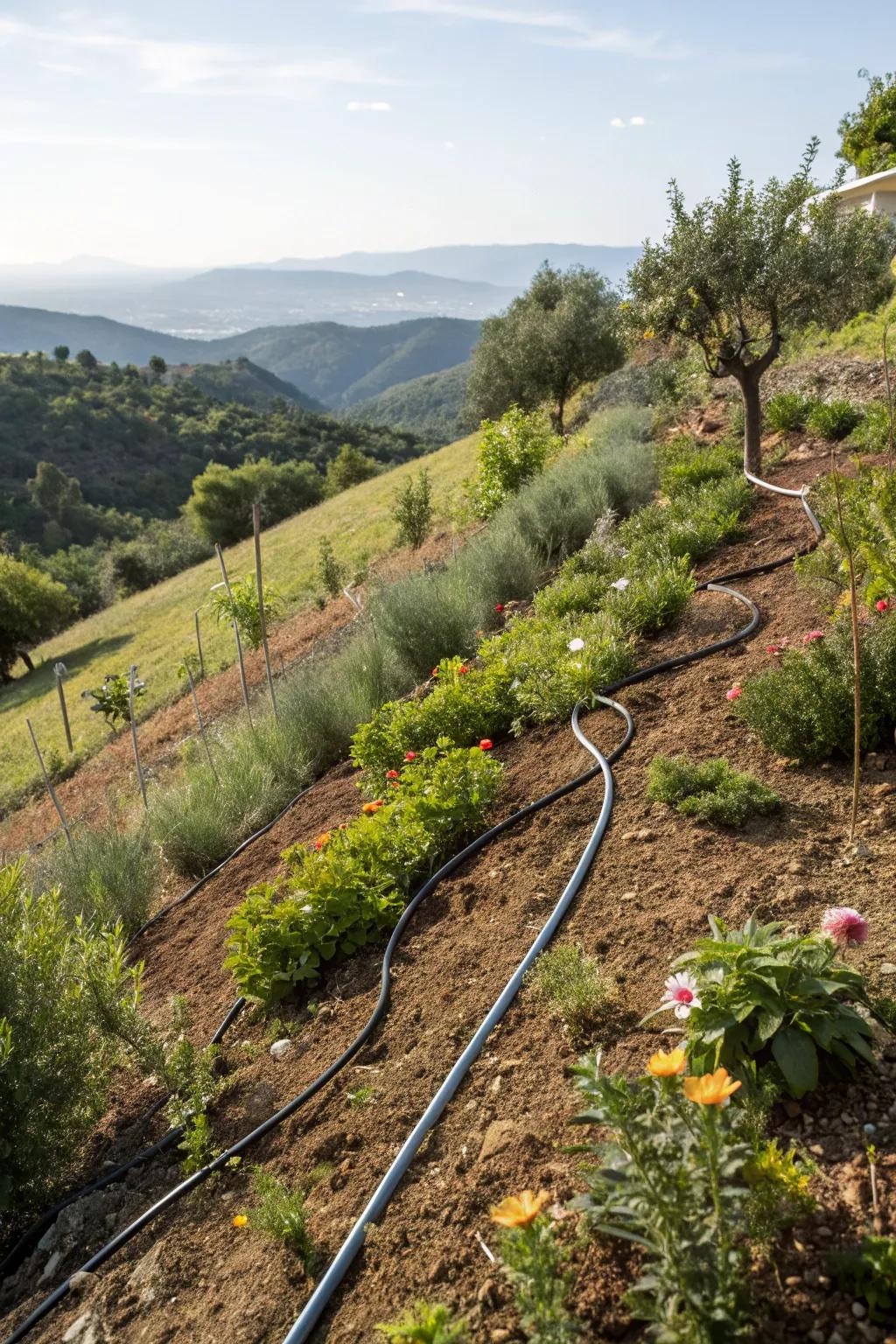
Watering a hillside can turn into a daily balancing act—too much and you risk runoff, too little and your plants struggle. Enter the magic of a simple drip irrigation system. I recently helped Raj, a passionate home gardener struggling with a patchwork of thirsty vegetable beds on a sun-drenched hillside. Together, we designed a custom drip layout, which not only conserved water but brought even growth across his entire slope. Raj’s tomatoes have never looked so lush!
Beyond the convenience, drip irrigation is all about precision. It’s designed to deliver moisture directly to plant roots, which limits evaporation and reduces weeds. Start by mapping out your beds and grouping plants with similar water needs.
- Choose flexible tubing that follows your hill’s unique contours.
- Install drip emitters at each plant so you can control the flow rate.
- Cover the tubing with mulch for neatness and extra moisture retention.
- Set a timer to automate watering—consistency is key for hillside gardens.
Give yourself the gift of time (and healthier plants) by investing a little effort upfront.
Consistency makes even the steepest garden flourish.
Check if these fit your needs:
9. Old Tires, New Life! Upcycled Planters with Personality
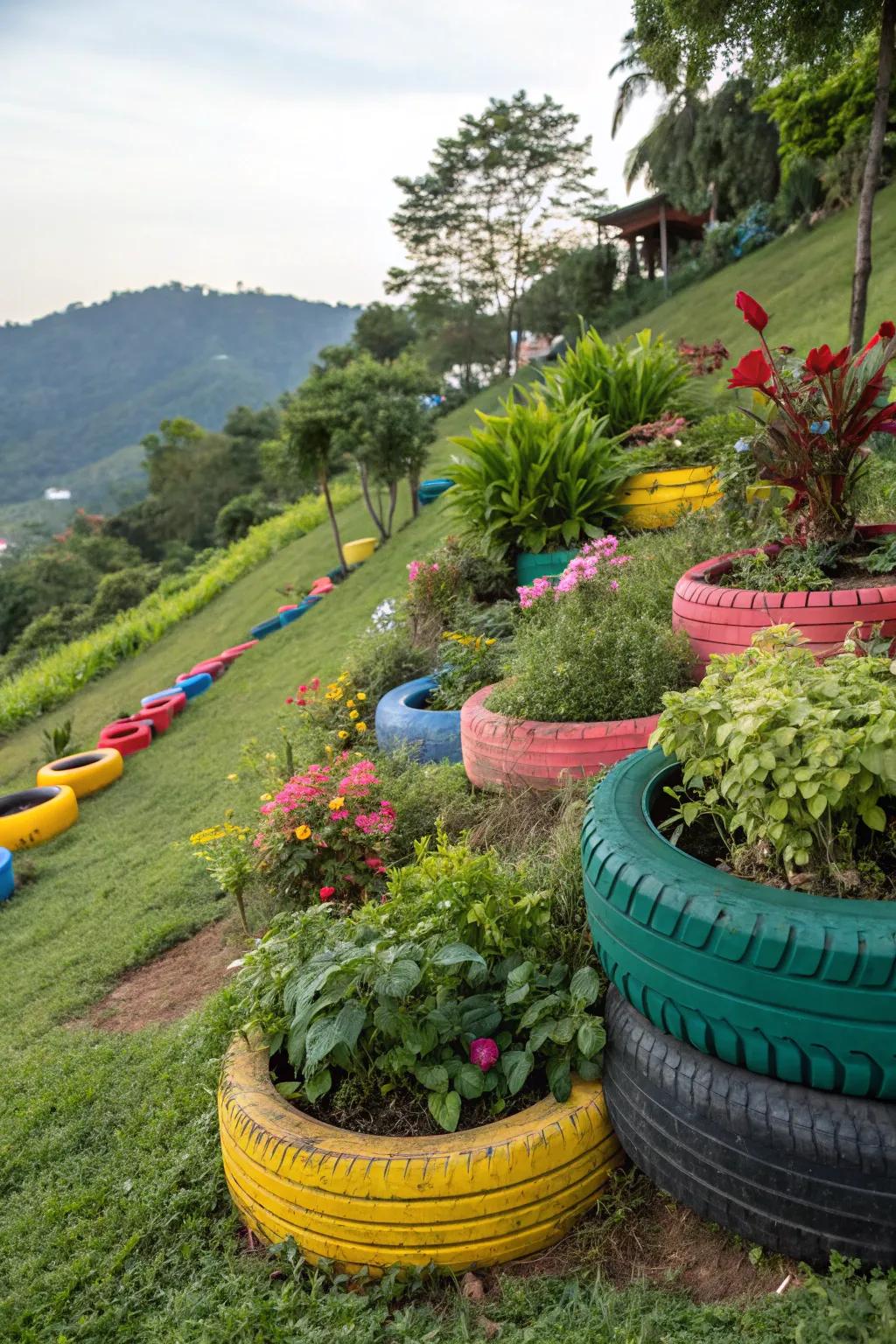
Sometimes the greatest garden treasures start as cast-offs. Turning old tires into vibrant planters is one of my favorite ways to cut costs and add instant personality to a hillside. I once worked with a creative client, Ben, who gathered tires from the neighborhood and challenged us to turn them into something special. We ended up with a collection of quirky, painted planters bursting with annuals and trailing vines.
It’s remarkable what a fresh coat of paint can do.
If you’re ready to create your own, start by cleaning the tires thoroughly and choosing colors that reflect your mood or your garden’s theme. Then, consider where to place them on the slope—staggered clusters work wonders for both drainage and style. Here are some playful ways to use upcycled tire planters:
- Stack two or three tires for dramatic height and extra soil depth.
- Paint bright patterns, stripes, or even whimsical faces for extra cheer.
- Cut and scallop the rims for a flower-petal effect.
- Plant trailing vines or cascading petunias to soften the tire edge.
With each new planter, your hillside becomes less of a junk heap and more of a living canvas. Try it and see the transformation for yourself!
Consider these options:
10. Turn Slopes Into Scenic Terraces With What Nature Offers
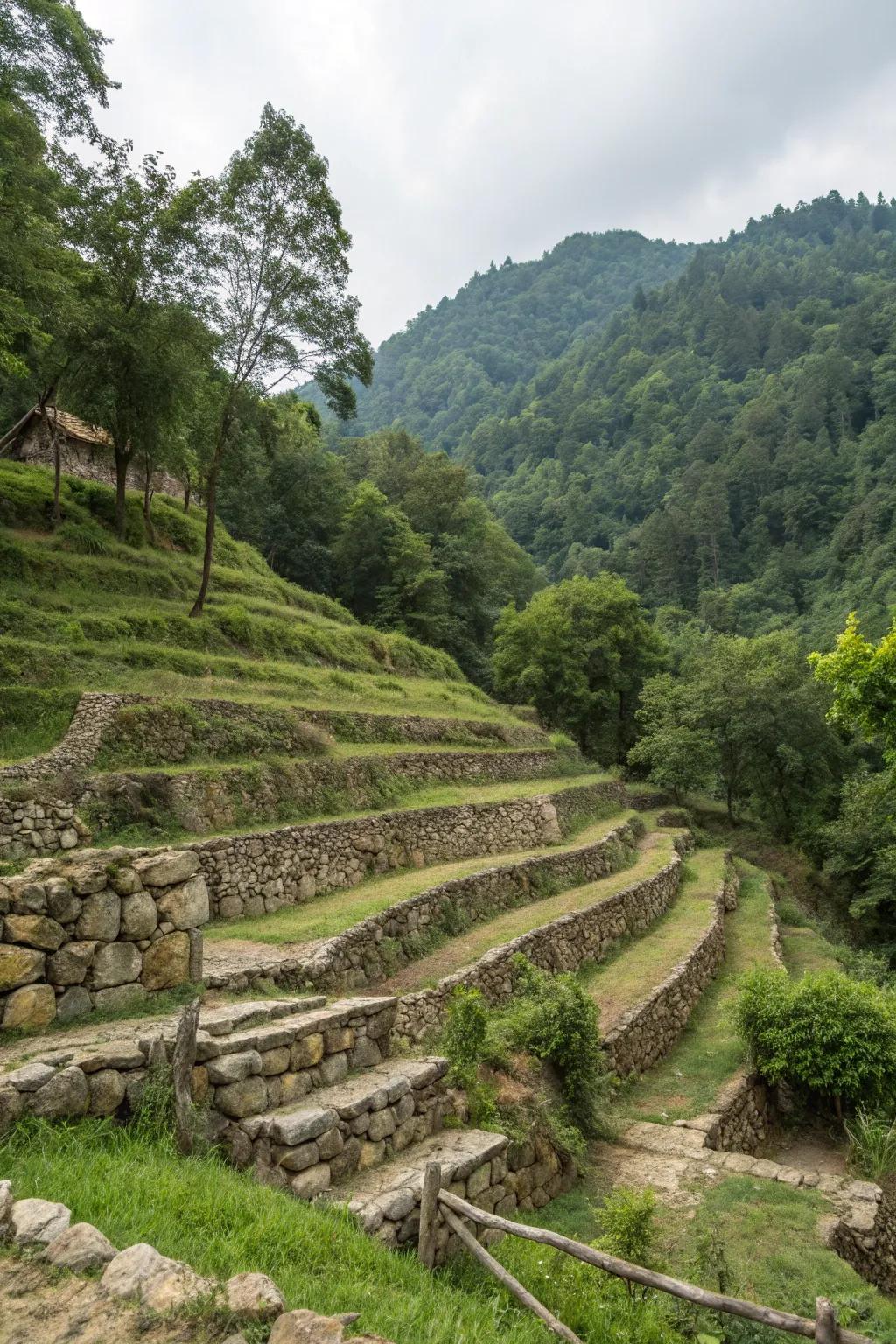
The secret to a thriving hillside garden is working with what you have—and with what the earth is already offering.
I’ll never forget the project I did with my clients, Linda and James. Their hillside backyard was a wild patch of weeds and rocky soil. Instead of carting in expensive materials, they took a walk through their own property. Together, we discovered sturdy fallen logs and clusters of beautiful, irregular stones—each one with its own texture and story. With a bit of elbow grease and plenty of laughter, we arranged the logs as terrace edges and made stone steps that hugged the natural slope. Not only did this save on costs, but it also helped maintain the harmony of the landscape. Linda told me later, “It feels like this has always belonged here.”
If you’re considering terracing, don’t rush to the garden center just yet! Look around for materials you already own or can find nearby. Here’s how to keep things affordable and charming:
- Reuse old timbers, rocks, or bricks to create layered levels.
- Mix materials—an artful blend feels both modern and earthy.
- Arrange terraces to slow water and prevent soil washing away.
You’ll find that “making a mountain out of a molehill” isn’t always a bad thing—sometimes, it’s a lovely way to create a backyard retreat.
Explore these options:
11. Maximizing Your Hillside: Spaces That Invite You In
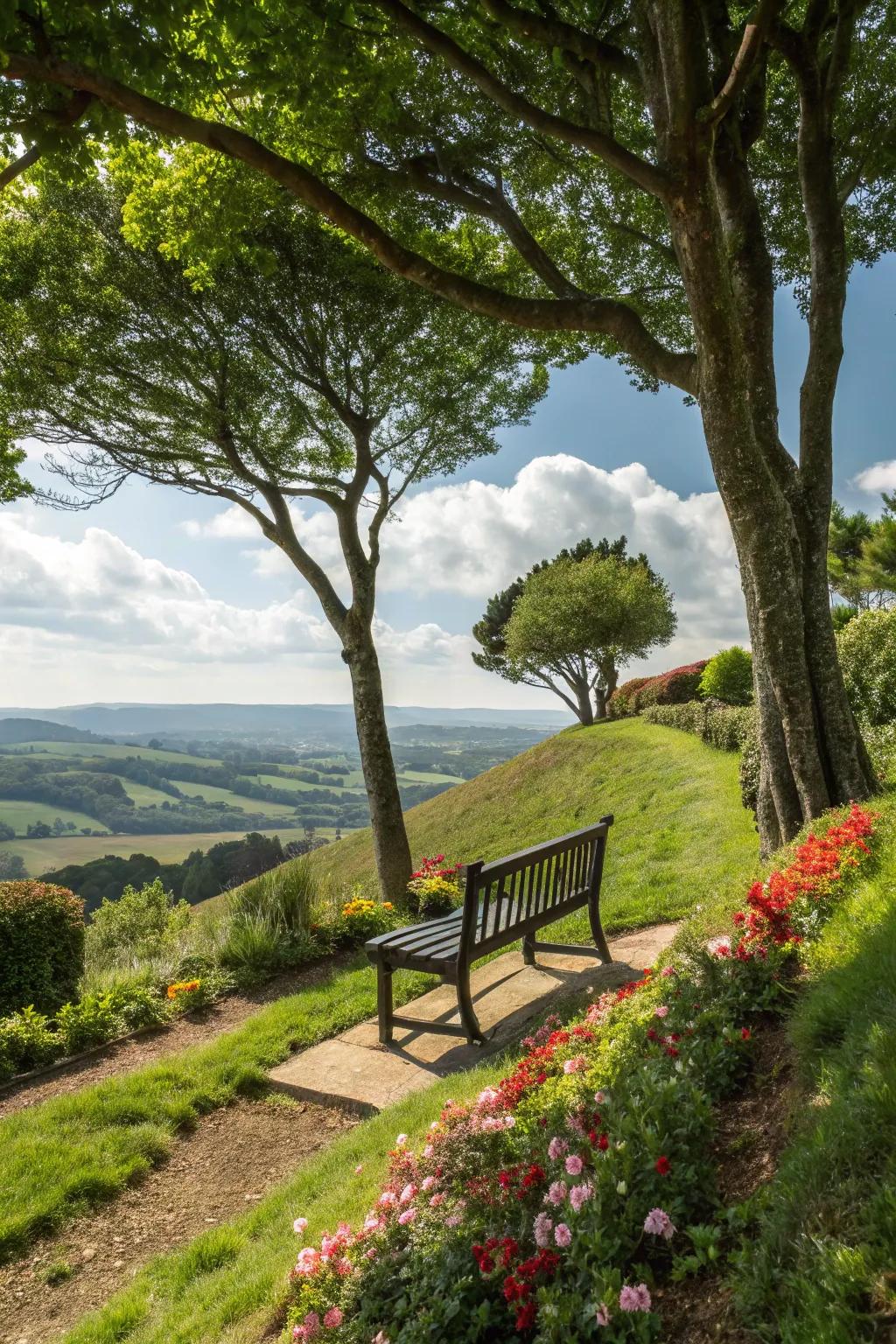
Hillside gardens shouldn’t just be seen from afar—they should invite you in to linger, lounge, and connect with nature.
- Tuck a bench into a shady nook for a peaceful reading spot.
- Define a small terrace with pavers or gravel—add a café table for morning coffee.
- Create a stepping path leading to your favorite view—a hidden retreat just for you.
I once worked with Sarah, a busy mom who wanted to reclaim her sloping yard for family time. We carved out a level pad for a weather-resistant bench and stitched winding paths among her lavender and grasses. It went from unused hillside to the heart of her home—proof that every slope can become a destination with a little heart and vision.
Useful items to consider:
12. Bursting with Color: Flowering Shrubs That Transform Your Slope
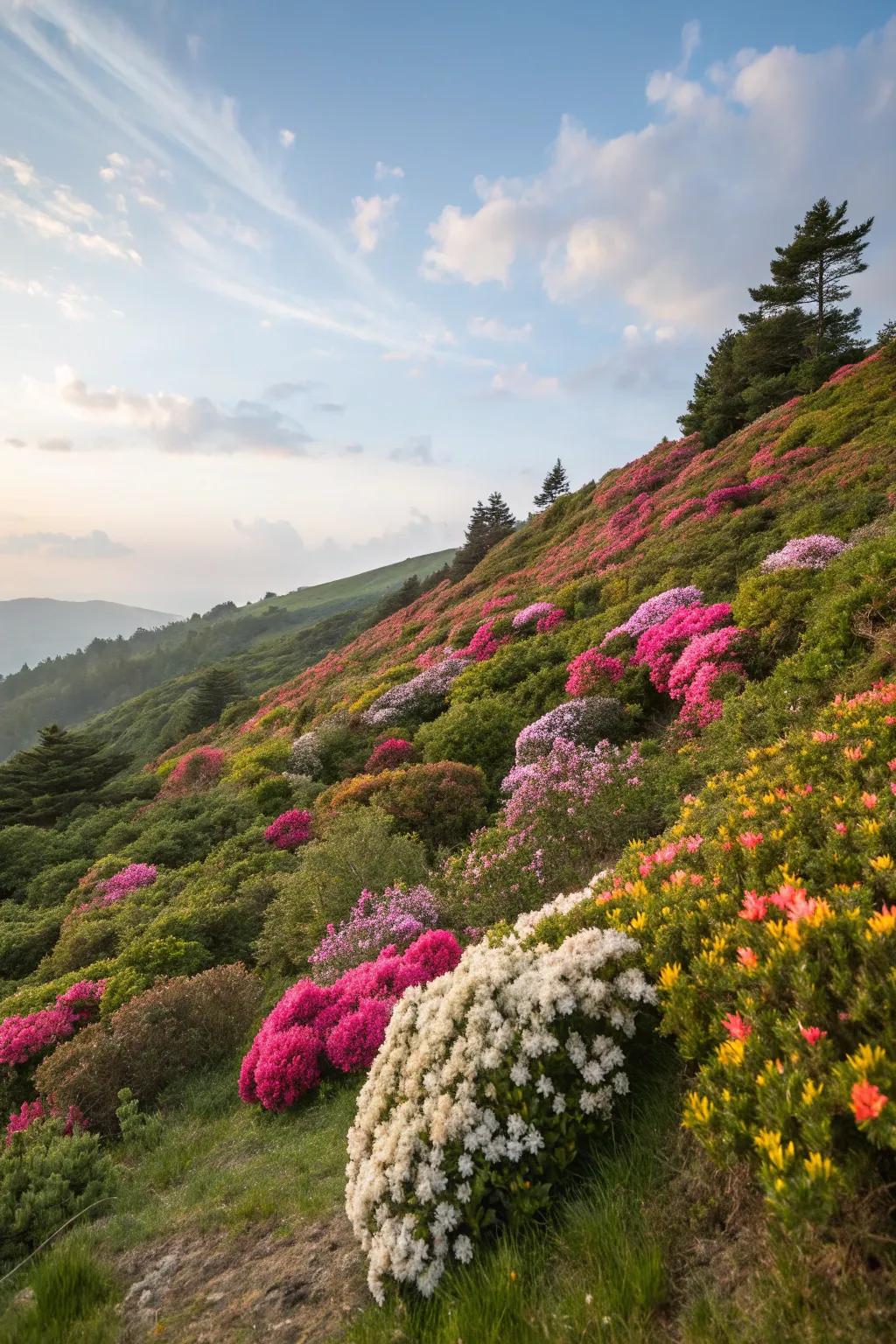
If you want your hillside to sing with color and charm, don’t overlook the power of flowering shrubs. These beauties can sweep through a landscape, creating living sculptures that bloom across the seasons.
There’s nothing quite like catching a glimpse of vibrant blossoms from across your yard.
Flowering shrubs do more than decorate—they bring texture, structure, and a bit of wild magic to your garden. To keep your slope both stunning and easy to maintain, I always recommend choosing shrubs that fit your soil and exposure, then grouping them for bold swathes of color.
- Plant in clusters rather than singles to amplify their presence and reduce lawn space.
- Choose a mix of early, mid, and late bloomers for ongoing interest.
- Don’t hesitate to prune boldly—shrubs bounce back and often bloom better with a confident cut!
I’ll never forget working with the Ramsey family on their steep backyard slope. We selected fragrant mock orange, spirea, and native azaleas, carefully tucking them in curved drifts beside their stone steps. That spring, their hillside burst into a tapestry of white and pink, humming with bees and butterflies. Linda said it best: “Now, every time I look outside, it feels like a living bouquet.”
With a little planning, you can enjoy a hillside that brims with color, pollinator activity, and pure seasonal joy.
A few helpful options:
13. What About Going Up Instead of Out?
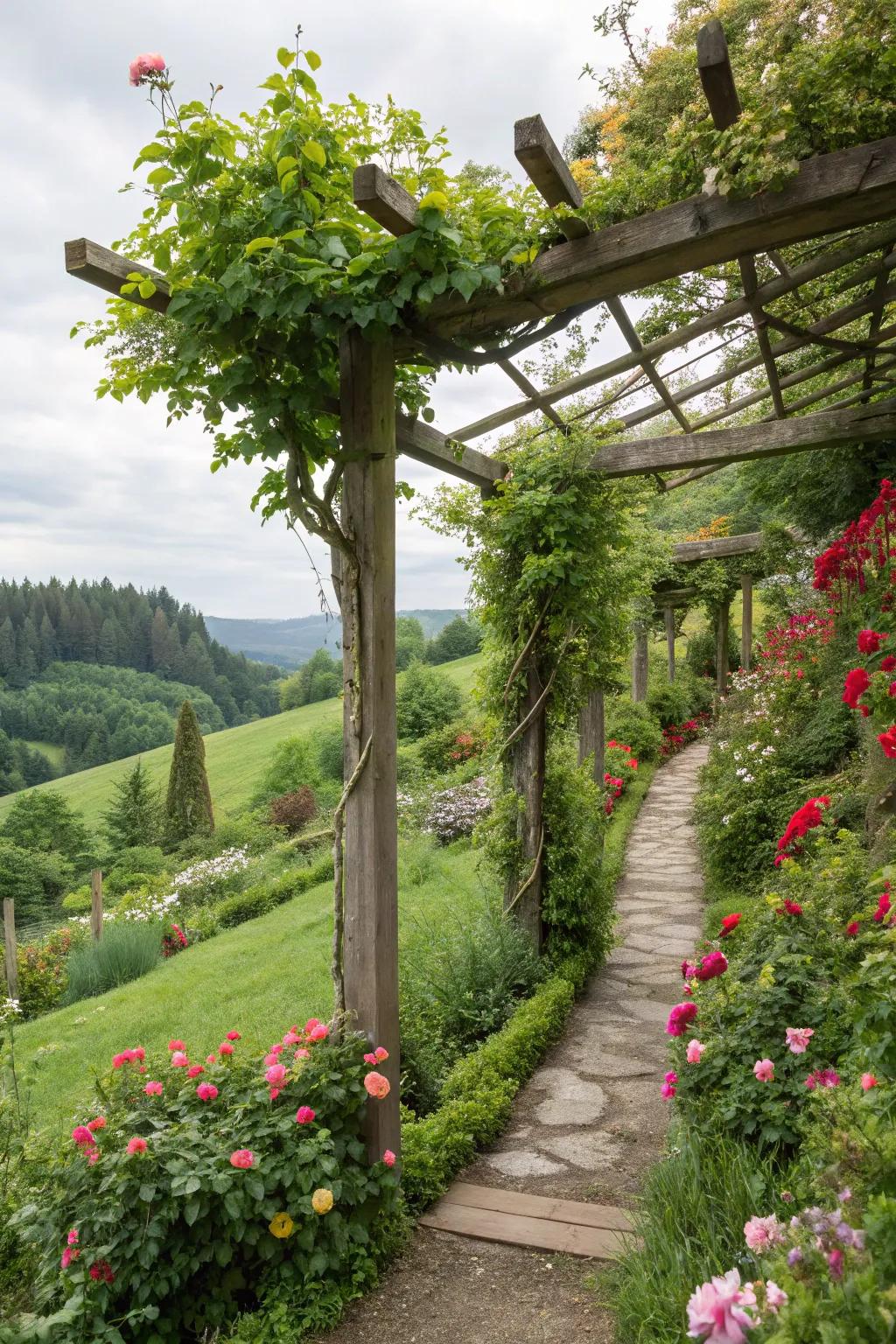
Vertical elements are a game-changer on the hillside—they create depth, anchor your eye, and offer support for flowering vines or fruits. A sturdy trellis or a decorative arbor helps break up the slope, guiding attention skyward and maximizing planting space even where ground may be limited. I often suggest these touches to clients who feel boxed in by a small or steep area—it’s amazing how a tall structure can instantly make the space feel more open and dramatic.
- Arbors can frame views or entries, adding a sense of arrival.
- Trellises let climbing roses or beans add privacy and lushness without breaking the bank.
Don’t be afraid to let your garden reach for the sky! With a little creativity, your slope won’t just be managed—it’ll become a showstopper.
Possibly handy products:
14. Rock Gardens: Sculpting Beauty Into the Hillside
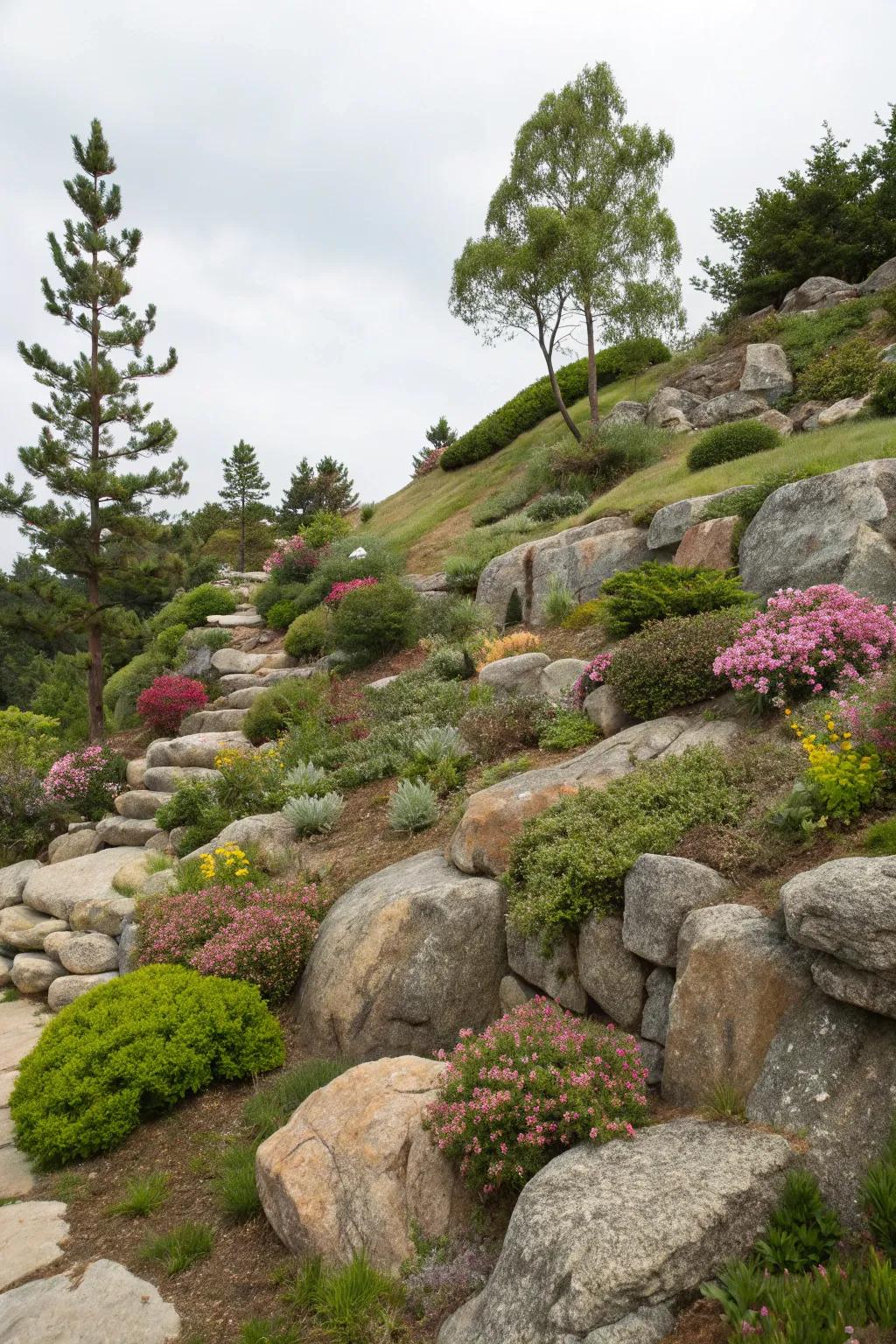
If you’re looking for a way to blend art and nature on a hillside, a thoughtfully designed rock garden is as rewarding as it is resilient. Rock gardens invite the wild beauty of nature close to home, and their low-maintenance charm makes them perfect for busy lives and tricky slopes alike.
- Start small: Cluster a variety of rocks—pebbles, flagstones, and boulders—to create depth and visual interest, especially on uneven terrain.
- Mix plants and stones: Nestle drought-tolerant plants like sedum or creeping thyme between the rocks for an effortless, naturalized effect.
- Play with levels: Arrange rocks in terraces or gentle slopes to slow water runoff and help your garden thrive through every season.
I once worked with the Harris family, who wanted a safe and stimulating play area for their three young children on a steep backyard slope. We curated smooth, rounded stones and arranged gentle step-downs interwoven with hardy groundcovers. Not only did this prevent erosion, but the kids discovered endless space for imaginative play among the stones and greenery, all with minimal maintenance effort for their parents.
Rock gardens invite the eye to wander and the mind to rest.
If you listen closely, a well-placed stone tells its own story—with texture, history, and a quiet sense of belonging.
These products might help:
15. Paths Elevate Everything
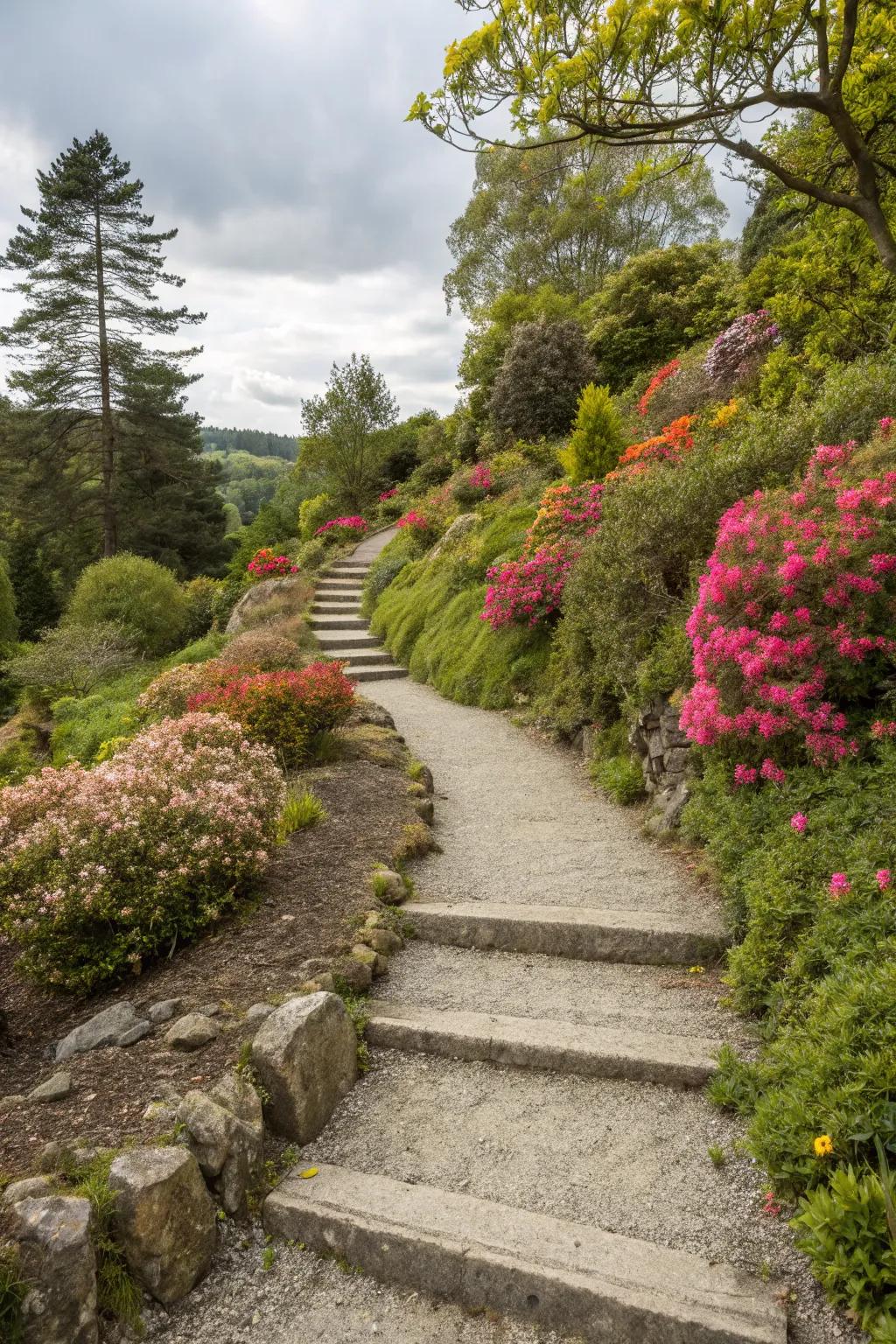
Never underestimate how much a simple path can change the game for your hillside—or how easy it can be on your budget.
Lay down gravel or stone, and suddenly your slope isn’t just beautiful—it’s accessible. A winding path makes every corner of your space feel special and intentional.
Some handy options:
16. A Gathering Glow: Simple Fire Pits for Hillside Evenings
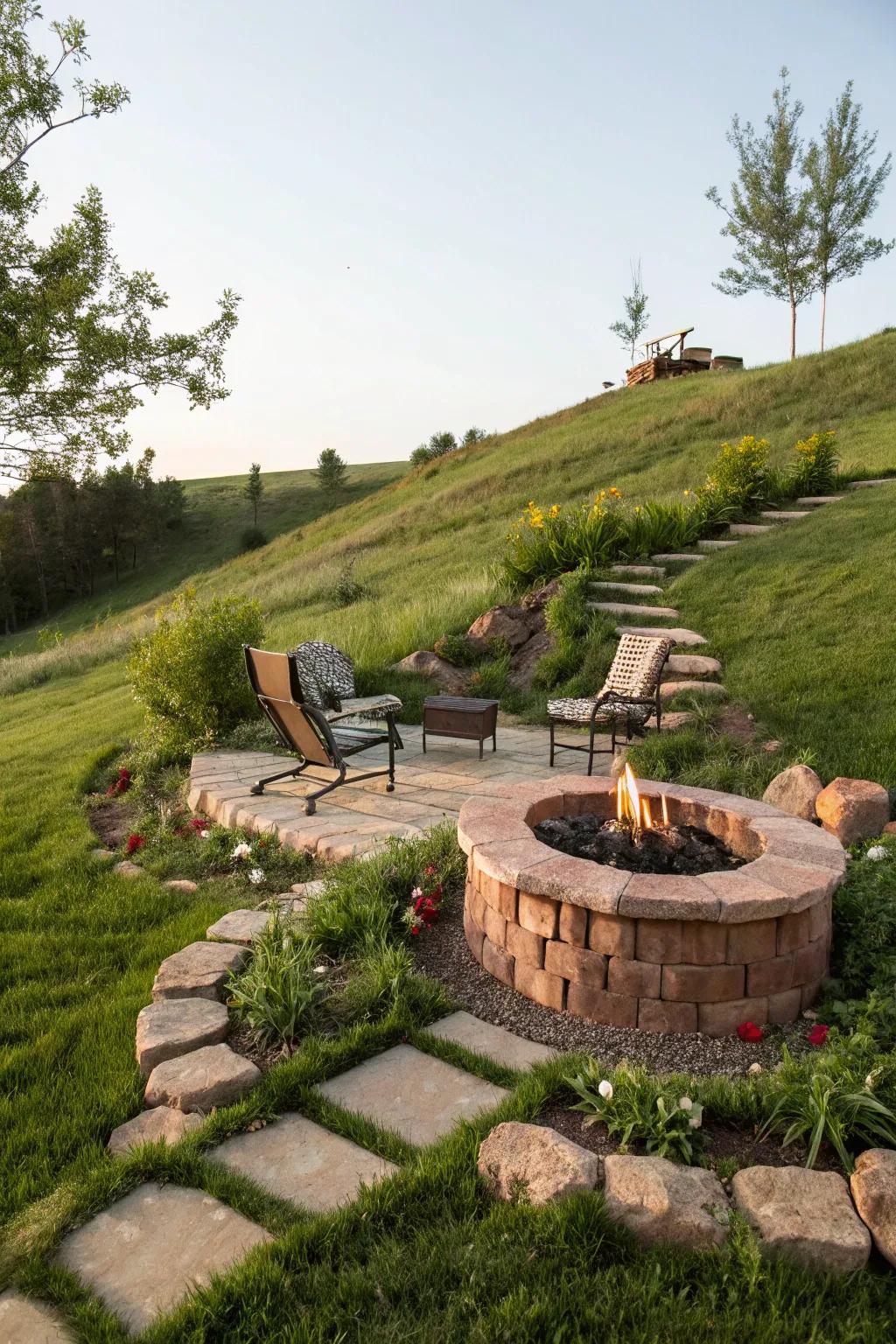
A fire pit isn’t just a feature—it’s an invitation. Warmth, flickering light, and the gentle crackle of wood draw friends and family to linger outdoors long after dusk. I find that adding a fire pit instantly creates an atmosphere of coziness and connection, especially on a sloped backyard that might otherwise be overlooked.
Nothing brings people together quite like a crackling fire.
Building your own can be refreshingly straightforward. Start by choosing a level section of your hillside, clearing away any debris or dry grass.
Next, use fire-safe bricks or a ring kit to shape the base, stacking them securely to contain the flames.
Finally, leave enough space around the pit for chairs or benches, so everyone has room to gather comfortably.
If you want inspiration, I recall helping the Morgans install a rustic fire pit halfway up their slope. We spent an afternoon stacking bricks and roasting marshmallows, turning an unused patch into the heart of their family evenings. They told me their hillside finally felt like home.
A few choices to try:
17. Planting for Success: Why Native Plants Make Hillside Gardening Easier (and Lovelier!)
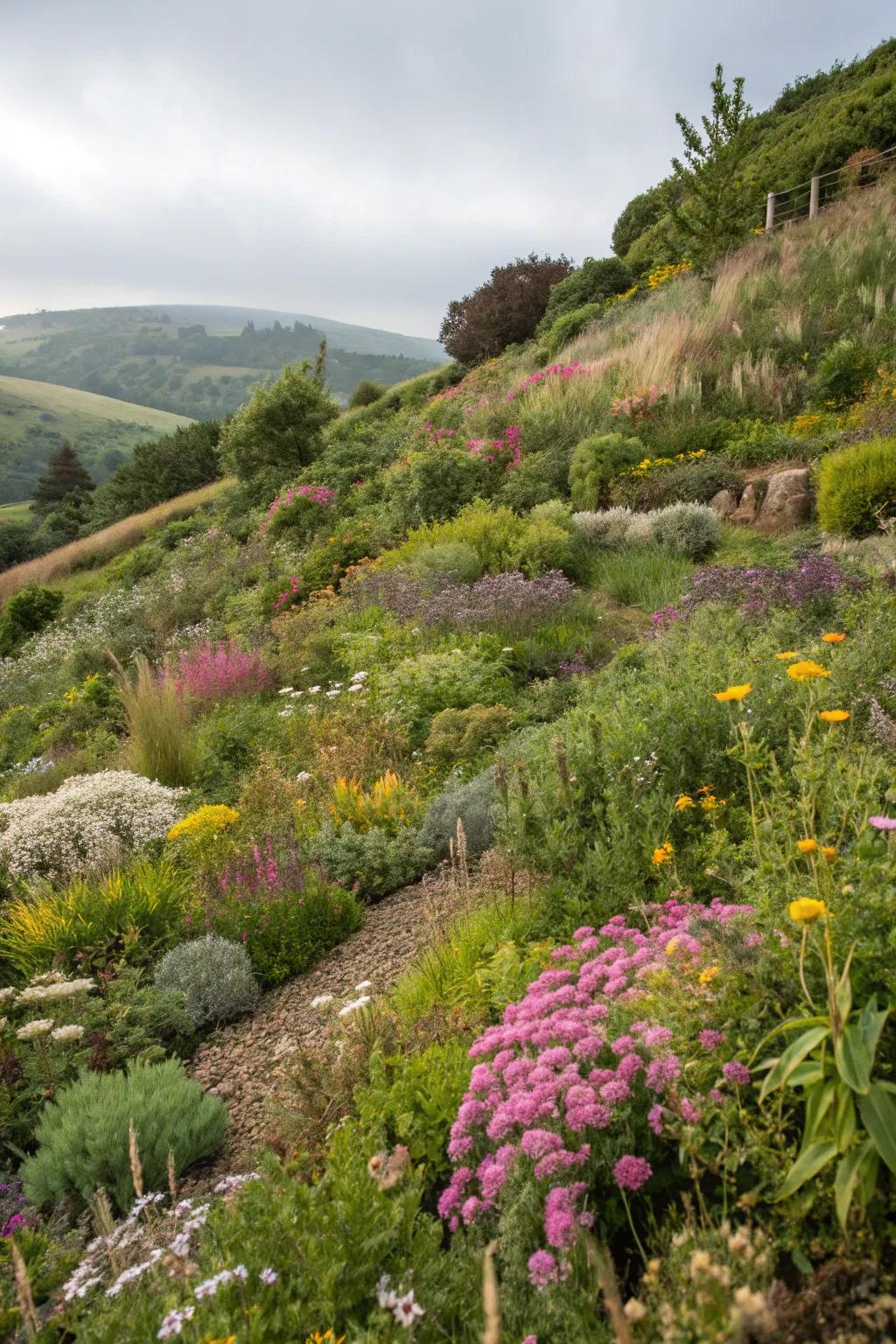
Choosing native plants is one of the wisest decisions you can make for a hillside—especially if you want stunning results with little fuss. Why fight nature? Native species are adapted to thrive in your conditions—less water, less worry, more beauty.
What could be simpler than working with plants that grew up around here, too?

